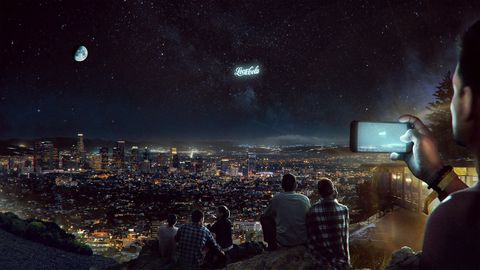A Russian Start-Up Wants to Project Giant Billboards in Space
Hope you love looking at giant Big Macs in the sky.
By Avery Thompson
STARTROCKET
One Russian company has announced a plan to build gigantic billboards in space, lighting up the night sky with advertisements for companies like Coke, McDonald’s, and KFC. If they’re successful, we could start seeing advertisements floating in the sky as soon as 2021.
On the one hand, this is a pretty incredible technological marvel. The company, StartRocket, plans to launch dozens of tiny CubeSats into orbit roughly 280 miles above the ground in a single rocket. Those CubeSats would then fly in formation and deploy giant reflective sails to send the sun’s light to Earth. Each one of these sails can be controlled independently, so the CubeSats act like programmable pixels. The billboards would only display advertisements for a year, according to a report from Astronomy.
This sort of stunt has never even been attempted before on this scale, so that makes this venture particularly impressive. But on the other hand, experts say this is a horrible way to waste this technology. University of Michigan astronomy professor Patrick Seitzer thinks the initiative is a bad idea.
He told Astronomy that space is already crowded, and that people probably don’t want to see giant ads for Big Macs blotting out the stars:
“Launching art projects like this with no commercial, scientific, or national security value seems unwise…Space is getting increasingly crowded. There are over 20,000 objects with orbits in the official public catalog maintained by the U.S. Air Force. Less than 10 percent of those objects are active satellites—the rest are dead satellites, old rocket bodies and parts of spacecraft.”
This type of aerial advertising would have to be approved by all kinds of regulatory agencies, and gaining that type of approval would ultimately take a long time. The tech may be ready by 2021, StartRocket says, but it's possible the public will not be.
Source: TechSpot, Astronomy
No comments:
Post a Comment